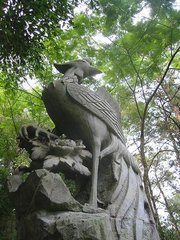Fenghuang(Japanese: hōō; Korean: bonghwang; Vietnamese : Phượng Hoàng) are mythological Chinese birds that reign over all other birds. The males are called Feng and the females Huang. In modern times, however, such a distinction of gender is often no longer made and the Feng and Huang are blurred into a single feminine entity so that the bird can be paired with the Chinese dragon, which has male connotations. Han Chinese often use the term "Descendants of the Dragon" as a sign of ethnic identity. The Fenghuang is also called the "August Rooster". In the West, it is commonly referred to as the Chinese phoenix and occasionally Ho-ho bird (from the Japanese name hō-ō).
Description
A common depiction was of it attacking snakes with its talons and its wings spread. The fenghuang is said to be made up of the beak of a cock, the face of a swallow, the forehead of a fowl, the neck of a snake, the breast of a goose, the back of a tortoise, the hindquarters of a stag and the tail of a fish. Its body symbolizes the six celestial bodies. The head is the sky, the eyes are the sun, the back is the moon, the wings are the wind, the feet are the earth, and the tail is the planets. Its feathers contain the five fundamental colors: black, white, red, blue and yellow.[1]
Origin
Fenghuang, the Chinese phoenix, has no connection with the phoenix of the Western world. The images of the phoenix have appeared in China for over 7,000 years, often in jade and originally on good-luck totems. It is a totem of eastern tribes in ancient China. Current theories suggest that it may be a representation of a large pre-historic bird, similar to an ostrich, which were common in pre-historic China.
During the Han Dynasty (2,200 years ago) the phoenix was used as a symbol depicting the direction south, shown as a male (feng) and female (huang) phoenix facing each other. It was also used to symbolize the Empress in a pairing with a dragon where the dragon represents the Emperor. It might come from the merging of eastern and western tribes of ancient China. The phoenix represented power sent from the heavens to the Empress. If a phoenix was used to decorate a house it symbolized that loyalty and honesty were in the people that lived there. Or alternatively, phoenix only stays when the ruling is without dark and corruption.
Meaning
The fenghuang has very positive connotations. It is a symbol of high virtue and grace. The fenghuang also symbolizes the union of yin and yang. It appears in peaceful and prosperous times but hides when trouble is near.
In ancient China, they can often be found in the decorations for weddings or royalty, along with dragons. This is because the Chinese considered the dragon and phoenix symbolic of blissful relations between husband and wife, another common yin and yang metaphor.
Popular culture
- In the Battletech universe, the Capellan Confederation's main warship class is known as the Feng Huang-class.
- In the game Guild Wars: Factions, in the explorable area Divine Path, rangers can tame a bird called a Phoenix, but is clearly modeled after a fenghuang. This bird attacks enemies by hopping at them, claws outstretched.
See also
References
- Mythical Realm: Phoenix Rising History, poems and images of the phoenix bird.

